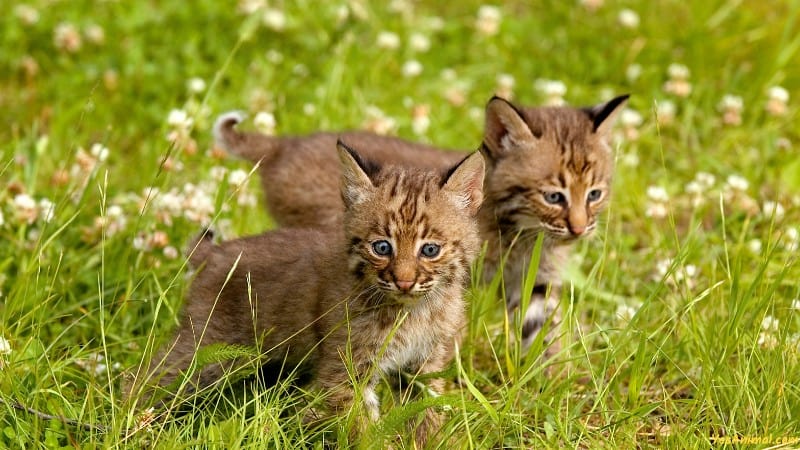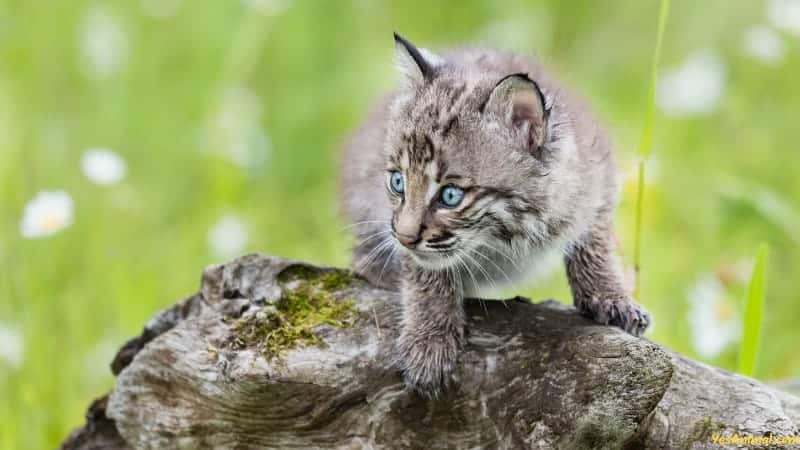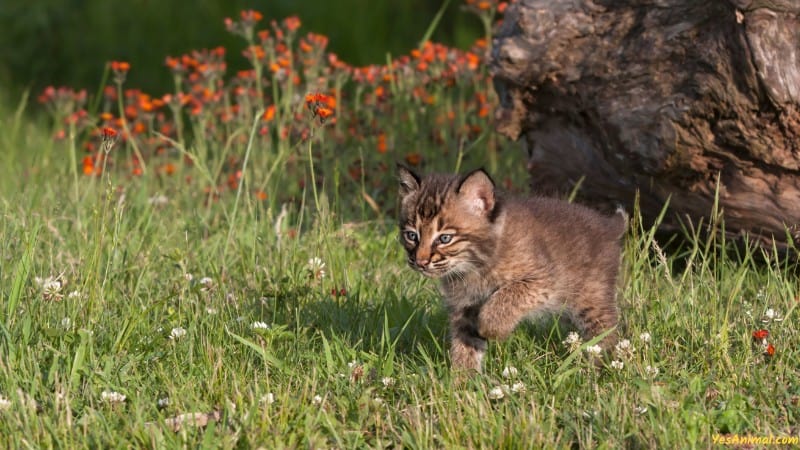Last Updated on April 15, 2024 by Amin Tawar
Bobcat Kittens Size Explained ( With Growth Chart)

Bobcat kittens are born blind, deaf, and only 8 to 12 ounces in weight. However, they grow quickly during their first year of life, gaining about 4-5 times as much weight in just a few short months.
Bobcat kittens are only 7 to 10 inches long when they are born, and they are entirely dependent on their mother to survive. As they get older, they begin to become more independent, learn how to hunt, and explore their surroundings.
Bobcat kittens can weigh between three and four pounds by the time they are three months old, and they have already started to resemble baby versions of their adult counterparts.
They can weigh up to 8 or 9 pounds at six months and are developing their hunting skills by learning how to pounce and catch prey on their own.
Bobcat kittens typically reach their full size by the time they turn one year old; males typically weigh 20 to 25 pounds, and females 15 to 20 pounds.
It’s important to keep in mind that these are only averages and that there can be significant differences in bobcat size and weight between individuals.
Overall, bobcat kittens are fascinating animals that undergo significant growth and development during their first year of life. By observing their growth chart and tracking their progress, we can gain a better understanding and appreciation for these beautiful creatures.
Here is a Bobcat Kitten Growth Chart to help you understand their size changes over time.
| Bobcat Age (Months) | Length (Inches) | Weight (Pounds) |
| At birth | 7-10” | 0.5-0.75 lbs |
| 1 month | 10-12” | 1.5-2.5 lbs |
| 2 months | 12-15” | 2.5-4 lbs |
| 3 months | 15-18” | 3-4 lbs |
| 4 months | 18-20” | 4-6 lbs |
| 5 months | 20-23” | 5-7 lbs |
| 6 months | 23-26” | 8-9 lbs |
| 7 months | 26-28” | 8-10 lbs |
| 8 months | 28-30” | 9-11 lbs |
| 9 months | 30-32” | 10-12 lbs |
| 10 months | 32-34” | 10-14 lbs |
| 11 months | 34-36” | 12-15 lbs |
| 12 months | 36-40” | 15-25 lbs |
What Do Bobcat Kittens Look Like?
Bobcat kittens are adorable and fascinating creatures that stand out from other felines by virtue of their distinct appearance.
They are easily recognizable thanks to their distinctive markings and features, and their playful nature is sure to win over animal lovers all over the world.
Here is a closer look at what bobcat kittens resemble, along with information on their appearance, behaviors, and relationship to adult bobcats.
Bobcat kittens can blend in with their surroundings thanks to their soft, spotted fur. Depending on where they live, their coat color can vary; some kittens have a reddish-brown coat, whereas others have a grayish-brown or yellowish-brown coat. Their necks have a distinguishing “ruff” of fur, which contributes to their rounder, more playful appearance.
Bobcat kittens have long legs, short tails, and sharp claws just like adult bobcats do. They can move through their habitat quietly and effectively thanks to their large paws, which have fur-covered black pads. At birth, their eyes are typically blue, but as they age, they gradually change, eventually turning a striking golden or green color.
How Much Do Bobcat Kittens Cost? (UK, India, US, Australia, and Canada )

It’s crucial to comprehend the costs associated with keeping a bobcat kitten as a pet if you’re thinking about doing so. The cost of owning a bobcat can vary depending on a number of factors. Bobcats are fascinating animals that need specialized care and attention. Here is a price list for bobcat kittens in the UK, India, US, Australia, and Canada, among other nations.
| Country | Price Range (in USD) | Factors That Affect Cost |
| UK | $8,000-$10,000 | Availability, import fees, transportation costs, legal permits |
| India | $5,000-$8,000 | Availability, breeder reputation, vaccination, and health costs |
| US | $1,500-$5,000 | Availability, breeder reputation, veterinary costs |
| Australia | $5,000-$8,000 | Availability, import fees, transportation costs, legal permits |
| Canada | $3,000-$6,000 | Availability, breeder reputation, veterinary costs |
It’s important to remember that keeping a bobcat kitten as a pet without a special permit is prohibited in many nations, including the US.
Owning a bobcat can be expensive even with a permit because they need specialized diets and living arrangements. Furthermore, keeping a wild animal requires a lot of responsibility and might not be appropriate for everyone.
Bobcat Kitten Diet? What Do They Eat?
As adorable as bobcat kittens are, it’s important to know what they eat in the wild and what they need to thrive in captivity.
In the wild, bobcat kittens primarily feed on small prey such as rodents, rabbits, and birds. They may also occasionally eat larger prey like deer and domestic livestock. As they grow and become more independent, their diet may expand to include insects and other small animals.
In captivity, it’s important to mimic their natural diet as closely as possible. A balanced diet for bobcat kittens in captivity typically consists of high-quality meat, such as chicken or rabbit, supplemented with vitamins and minerals. It’s also important to provide fresh water at all times.
As with any wild animal in captivity, it’s crucial to consult with a veterinarian or animal expert to ensure the proper care and nutrition of the bobcat kitten.
Bobcat Kitten Behavior? Are They Friendly Or Aggressive?
Bobcat kittens have adorable fluffy fur and a playful disposition. They can exhibit a wide range of behaviors, though, just like all wild animals. Bobcat kittens are generally not hostile to people, but they also do not have a tendency to be amiable.
Bobcat kittens are wary of people and other potential threats because they are born with a strong instinct for survival and self-preservation.
As they grow older, they become more independent and may become warier of people. When they are young, they learn how to hunt and defend themselves from their mother.
But it’s crucial to keep in mind that bobcat kittens are still wild animals and subject to unpredictable behavior. They may not be inherently hostile to people, but if they feel threatened or cornered, they may react defensively or fearfully.
Do Bobcat Kittens Sleep & Shed A Lot?
Amazing creatures like bobcat kittens captivate people with their captivating appearance and elusive nature. Despite the fact that these wild animals are not typically kept as pets, many people are curious about their habits and traits. Find out if bobcat kittens sleep a lot and shed a lot by reading on.
Like most young animals, bobcat kittens need a lot of sleep. They spend the first few weeks of their lives sleeping and nursing because they are born with their eyes closed.
Even though they may sleep less and become more active as they age, they still need plenty of sleep to support their physical and mental development.
Additionally, Bobcat kittens do shed their fur, but the amount that they shed varies depending on a number of variables, such as their age, health, and living circumstances. Even though their dense, soft fur isn’t typically regarded as hypoallergenic and provides excellent insulation from the cold.
How Do You Tell If A Kitten Is A Bobcat?

Bobcats are elusive creatures with distinctive looks and behavior. Even though bobcats are typically not kept as pets, occasionally people come across them in the wild and mistake them for domestic kittens. Here are some telltale signs to watch out for when attempting to identify a bobcat kitten.
One of the most distinctive features of a bobcat kitten is its spotted coat. Bobcats have short, rust-colored fur with black spots all over their legs and belly.
They are well insulated from the cold by their thick, soft coat. In addition, they have tufted ears and short, bobbed tails, from which they get their name.
In terms of behavior, bobcat kittens are generally cautious and wary of humans. They are born with their eyes closed and spend the first few weeks of their lives nursing and sleeping in a den.
As they grow older, they become more active and may explore their surroundings, but they are still highly dependent on their mother for protection and guidance. 1
What does a bobcat kitten sound like?
Because of their distinctive appearance and elusive nature, bobcat kittens are fascinating creatures that stand out from the crowd.
Even though bobcats are typically not kept as pets, occasionally people hear the sounds of bobcat kittens in the wild and wonder what they sound like. To learn more about bobcat kitten vocalizations, keep reading.
Bobcat kittens use a variety of sounds to communicate with their mother and siblings even though they don’t have a powerful voice.
When they are young, kittens meow softly to attract their mother’s attention and communicate their needs. As they get older, they might chirp, growl, or hiss to communicate with their mother or siblings.
Are Bobcat Kittens Good Pets? Is A Bobcat A Good House Cat?
It is important to address the issue of whether bobcat kittens make good pets, keeping in mind that bobcats are wild animals and are not typically kept as pets.
Despite the fact that they are undeniably adorable and fascinating, they are not domesticated and do not exhibit the same social or behavioral characteristics as house cats.
Trying to keep a kitten as a pet can be harmful to both the bobcat and the person trying to care for it. Because they are territorial and can become hostile as they age, bobcats can be dangerous to other animals or people inside the house.
Additionally, they have particular dietary and environmental requirements that are challenging to meet in a domestic setting.
In addition to the risks to animals and humans, it is also illegal to keep bobcats as pets in most areas. Bobcats are protected under state and federal laws, and attempting to keep them without proper permits can result in fines or legal action.
Bobcat Kitten Compared To Regular Kitten
Although both domestic and bobcat kittens are indubitably adorable and fascinating creatures, they are very different in terms of appearance, behavior, and care requirements. To learn more about bobcat kittens and other kinds of kittens, keep reading.
One of the most obvious differences between domestic and bobcat kittens is their appearance. Bobcat kittens have short, reddish-brown fur with black spots on their legs and bellies.
They also have tufted ears and short, bobbed tails. Domestic kittens, on the other hand, come in a wide range of coat colors and patterns, including tabby, calico, and solid black.
Conclusion
And that was everything you need to know about the Bobcat Kitten. I hope this article was informative enough and your queries were answered.
Thank You For Reading!
Related Articles You May Like